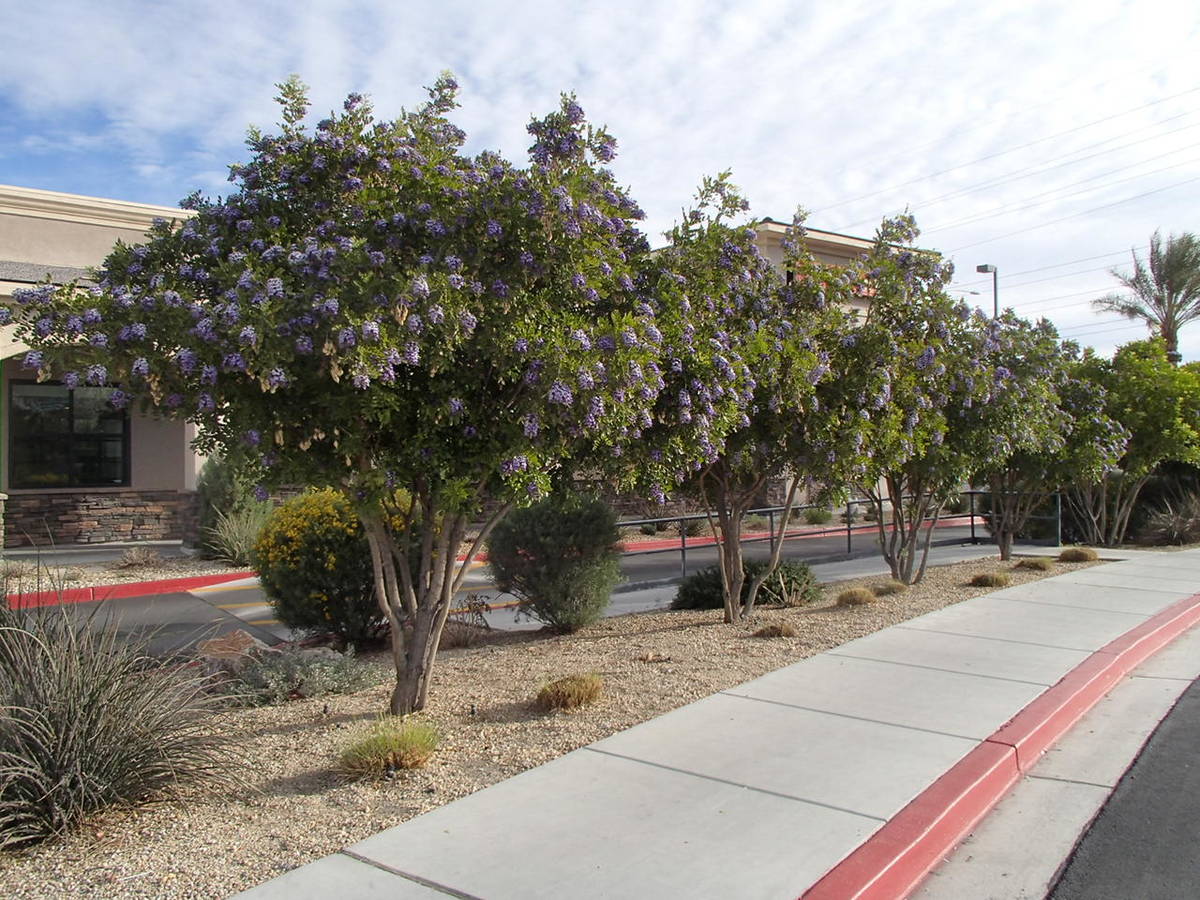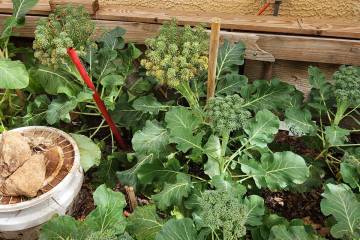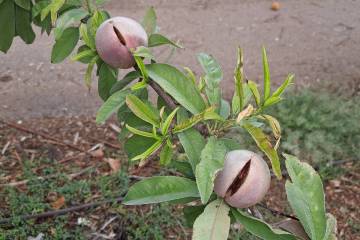The most effective ways to water desert plants
Three principles are important when watering trees, shrubs, fruit trees and any other landscape plants: Apply water at the right time, apply it over a large area and apply it to the right depth. The difference between Southwestern desert plants and other types of plants used for landscaping is the timing, or when the water is applied.
Plants that originate from our desert Southwest can go longer between waterings than plants that originate from other dry parts of the world. This is why our desert natives used for landscaping are watered less often than other landscape plants.
Drip irrigation is the most familiar way to irrigate in the desert, but using bubblers to apply the water very rapidly into a moat or ring around the plants is equally effective. These moats are identical in size and location to where drip emitters are placed.
But the slow release of water from drip emitters doesn’t require moats to contain water. Instead, water released from drip emitters is so slow that it enters the soil exactly where it’s applied and then spreads to the roots growing underground.
How much of the area under a plant should receive water? The University of Arizona tells its master gardeners to apply water to 100 percent of the soil under a plant’s canopy. The canopy of a plant is the leaves and branches that shade the ground at high noon during the summer.
More realistically, perhaps, if at least half of this shaded area receives water then it is probably good enough. This means as plants get larger, though, their need for this applied water increases, and the area of application gets larger as these plants get bigger.
How many minutes should the controller deliver water? I don’t like to talk about how many minutes but instead about wetting all the roots under the plant canopy and creating a reservoir of deep water there.
How do you know if the applied water penetrated deep enough? Push a long piece of skinny rebar into the soil in several spots under the canopy. It slides into wet soil easily wherever there aren’t rocks. Rebar stops sliding when it hits dry soil.
Large plants need deep reservoirs of water. Smaller plants are happy with smaller soil reservoirs.
During the coldest part of winter, irrigation water is applied to landscape plants about every 10 days to two weeks. During the heat of the summer, water might be applied as often as every two to three days. Plants originating from our deserts are watered less frequently, and these irrigations are used to encourage growth and shade.
Q: You recently talked about watering a lemon tree about 8 feet tall. How would you water a tree like that?
A: All citrus planted by homeowners are watered the same way. Remember one thing: Never water these trees every day, even when it’s really hot.
The trick to watering citrus is to apply water so that it wets the roots to about 18 inches deep and then hold off watering again until the next irrigation is needed. In the summer this might be one or two days apart. In the winter, it might be 10 days apart.
We are told to water the soil under the tree canopy deeply but infrequently. This advice is incomplete.
Instead, distribute the applied water on top of the soil so that it wets the roots to an area equal to the spread of its branches and wets the soil to a depth of 18 inches. This holds the water in the soil under the tree in a reservoir.
Never apply irrigation water right at the tree trunk. That is a mistake.
How to do this? When the tree is first planted, use two drip emitters on either side of the trunk about 12 inches away. In about three years, a couple more emitters will be added because the tree is bigger.
At this tree size, increase the number of drip emitters to four, all 12 inches from the trunk. When the tree is about 6 or 7 years old, the number of emitters will be increased to about six or seven. If the water is applied so the roots of these trees are wet to a depth of 18 inches, then six or seven emitters may be enough for its entire life.
Use single drip emitters connected to one-quarter-inch spaghetti tubing or use the Netafim-type drip tubing distributed in a coil around the tree. Both work. Make sure the tree gets the same amount of water whether single emitters or drip tubing is used.
Q: I am getting rid of my lawn around my oak and converting the lawn sprinklers to drip lines. The tree is 29 years old and has a diameter of 11.4 inches. How many gallons of water a week should the oak get?
A: No one can tell you exactly the gallons needed by your oak tree. From research we conducted and my experience, I am guessing an oak tree that size needs 150 to 200 gallons of water per day during the summer months.
For sure, the lawn was a major contributor of water for the tree. We can talk about how to make this retrofit from lawn to drip irrigation so that the tree has the best chance of survival.
The usual mistake made when a lawn is eliminated and the tree converted to a few drip emitters is that the tree does not get enough water. This method will not deliver enough water to the tree. You will see large limbs dying and possibly tree death.
Instead, first convert the valve used for the lawn sprinklers to drip irrigation by adding a pressure regulator and a drip filter. Next, use the Netafim-type drip tubing connected to this retrofitted sprinkler valve. Coil this drip tubing around the tree several times so that the spirals are 18 inches apart and cover the entire lawn area under the tree’s canopy.
I am guessing the length of the Netafim-type drip tubing needed under the tree would be somewhere around 150 feet long. This spiral of drip tubing will now deliver water to the entire area under the canopy of the tree. Cover this retrofitted lawn area under the tree, and the drip tubing, with woodchips 4 inches deep.
Next, encourage the roots to grow more deeply through irrigation. The majority of tree roots growing in a lawn are not growing deep.
The first year of irrigation after the retrofit, irrigate the tree with this drip system every other day during the hot summer months while the established tree roots get accustomed to the absence of lawn sprinklers. Begin increasing the minutes but applying water less often during the cooler fall and spring months.
By the second year, tree roots should be redistributed in the soil and favor the application of water by the drip system.
Q: I moved the drip emitters for my peach tree farther out from the trunk to about 1½ to 2 feet apart. Last year, they were about 1 foot from the trunk. I don’t know if this is something to be done again as the tree gets larger (canopy) or simply leaving it at 1½ to 2 feet from the trunk should be good for the life of the tree.
A: Maybe it helps if I explain how I irrigate trees as they get larger. When first planting a 5- to 15-gallon tree, I use two drip emitters about 12 inches from the trunk for the first season of growth. The number of minutes can range from 30 minutes to an hour. The number of minutes depends on how much water these drip emitters deliver, but I make sure water from them wets the soil to a depth of at least 18 inches.
The second year in the ground I use four drip emitters about 12 to 18 inches from the trunk. The number of minutes of applied water doesn’t change. This doubling of the drip emitters doubles the amount of water the trees are given. This increase in the number of drip emitters gives this larger tree more water, which it needs.
During the third or fourth year — and if the tree has grown considerably — I add two or three more drip emitters under the tree (depending on its size) and distribute them about 18 inches apart. If the peach tree is pruned to about 8 to 10 feet tall, six or seven drip emitters should be enough for the life of the tree. If the tree is allowed to get much bigger than this, then more emitters will be needed.
Bob Morris is a horticulture expert and professor emeritus of the University of Nevada, Las Vegas. Visit his blog at xtremehorticulture.blogspot.com. Send questions to Extremehort@aol.com.























